Identification of Sedimentary Environments through Dynamic Image Analysis of the Particle Morphology of Beach Sediments on the East and West Coasts of Hainan Island in South China
Abstract
:1. Introduction
2. Materials and Methods
2.1. Study Area
2.2. Sediment Sampling
2.3. Dynamic Image Analysis (DIA)
2.4. Morphological Diversity Index and Statistical Analysis
3. Results
3.1. Morphology Distribution Parameter and Diversity
3.2. Statistical Analyses
3.3. Shannon Index Difference
4. Discussion
4.1. Identifying the Depositional Environment
4.2. Morphological Fingerprints of Particle Samples
4.3. Particle Morphology in Hydraulic and Aeolian Environments
5. Conclusions
Author Contributions
Funding
Data Availability Statement
Acknowledgments
Conflicts of Interest
References
- Petrak, D.; Dietrich, S.; Eckardt, G.; Köhler, M. Two-dimensional particle shape analysis from chord measurements to increase accuracy of particle shape determination. Powder Technol. 2015, 284, 25–31. [Google Scholar] [CrossRef]
- Sun, Y.; Cai, Z.; Fu, J. Particle morphomics by high-throughput dynamic image analysis. Sci. Rep. 2019, 9, 1–11. [Google Scholar] [CrossRef] [PubMed] [Green Version]
- Pettijohn, F.J.; Potter, P.; Siever, R. Sand and Sandstone, 2nd ed.; Springer: New York, NY, USA, 1972; pp. 97–135. [Google Scholar]
- Gao, S.; Collins, M. Analysis of grain size trends, for defining sediment transport pathways in marine environments. J. Coast. Res. 1994, 10, 70–78. [Google Scholar]
- Cheng, P.; Gao, S.; Bokuniewicz, H. Net sediment transport patterns over the Bohai Strait based on grain size trend analysis. Estuar. Coast. Shelf Sci. 2004, 60, 203–212. [Google Scholar] [CrossRef]
- Ma, L.; Wu, J.; Abuduwaili, J. Variation in aeolian environments recorded by the particle size distribution of lacustrine sediments in Ebinur Lake, Northwest China. SpringerPlus 2016, 5, 481. [Google Scholar] [CrossRef] [Green Version]
- Liang, A.; Dong, Z.; Qu, J.; Su, Z.; Zhang, Z.; Qian, G.; Gao, J.; Pang, Y.; Yang, Z. Using spetial variations of grain size to reveal sediment transport in Kumtagh Sand Sea, Northwest China. Aeolian Res. 2020, 46, 100559. [Google Scholar] [CrossRef]
- Shang, Y.; Kaakinen, A.; Beers, C.; Prins, M. Aeolian silt transport processes as fingerprinted by dynamic image analysis of the grain size and shape characteristics of Chinese loess and Red Clay deposits. Sediment Geol. 2018, 375, 36–48. [Google Scholar] [CrossRef]
- Domokos, G.; Jerolmack, D.; Sipos, A.; Török, Á. How river rocks round: Resolving the shape-size paradox. PLoS ONE 2014, 9, e88657. [Google Scholar] [CrossRef] [Green Version]
- Miller, K.; Szabó, T.; Jerolmack, G.; Gábor, D. Quantifying the significance of abrasion and selective transport for downstream fluvial grain size evolution. J. Geophys. Rese. Earth Sur. 2014, 119, 2412–2429. [Google Scholar] [CrossRef] [Green Version]
- Novák-Szabó, T.; Sipos, A.; Shaw, S.; Bertoni, D.; Pozzebon, A.; Grottoli, E.; Sarti, G.; Ciavola, P.; Domokos, G.; Jerolmack, D. Universal characteristics of particle shape evolution by bed-load chipping. Sci. Adv. 2018, 4, eaao4946. [Google Scholar] [CrossRef] [Green Version]
- Xiu, H.; Ma, F.; Li, J.; Zhao, X.; Liu, L.; Feng, P.; Yang, X.; Zhang, X.; Kozliak, E.; Ji, Y. Using fractal dimension and shape factors to characterize the microcrystalline cellulose (MCC) particle morphology and powder flowability. Powder Technol. 2020, 364, 241–250. [Google Scholar] [CrossRef]
- Wang, J.; Li, Z.; Cai, C.; Ma, R. Particle size and shape variation of Ultisol aggregates affected by abrasion under different transport distances in overland flow. Catena 2014, 123, 153–162. [Google Scholar] [CrossRef]
- Polakowski, C.; Sochan, A.; Bieganowski, A.; Ryzak, M.; Földényi, R.; Tóth, J. Influence of the sand particle shape on particle size distribution measured by laser diffraction method. Int. Agrophys. 2014, 28, 195–200. [Google Scholar] [CrossRef]
- Guan, R.; Guang, L.; Di, H.; Zhou, C. Effect of particle shape on mechanical behaviors of rocks: A numerical study using clumped particle model. Sci. World J. 2013, 2013, 589215. [Google Scholar]
- Mulchrone, K.; McCarthy, D.; Meere, P. Mathematica code for image analysis, semi-automatic parameter extraction and strain analysis. Comput. Geosci. 2013, 61, 64–70. [Google Scholar] [CrossRef]
- Sarocchi, D.; Sulpizio, R.; Macías, J.; Saucedo, R. The 17 July 1999 block-and-ash flow (BAF) at Colima Volcano: New insights on volcanic granular flows from textural analysis. J. Volcanol. Geotherm. Res. 2011, 204, 40–56. [Google Scholar] [CrossRef]
- Charpentier, I.; Sarocchi, D.; Sedano, L.A.R. Particle shape analysis of volcanic clast samples with the Matlab tool MORPHEO. Comput. Geosci. 2013, 51, 172–181. [Google Scholar] [CrossRef]
- Polo-Díaz, A.; Benito-Calvo, A.; Martínez-Moreno, J.; Mora, T.R. Formation processes and stratigraphic integrity of the Middle-to-Upper Palaeolithic sequence at Cova Gran de Santa Linya (Southeastern Prepyrenees of Lleida, Iberian Peninsula). Quat. Int. 2016, 417, 16–38. [Google Scholar] [CrossRef]
- Sokołowski, T.; Wacnik, A.; Woronko, B.; Madeja, J. Eemian-Weichselian Pleniglacial fluvial deposits in southern Poland (an example of the Vistula River valley in Kraków). Geol. Q. 2014, 58, 71–84. [Google Scholar]
- Suzuki, K.; Fujiwara, H.; Ohta, T. The evaluation of macroscopic and microscopic textures of sand grains using elliptic Fourier and principal component analysis: Implications for the discrimination of sedimentary environments. Sedimentology 2015, 62, 1184–1197. [Google Scholar] [CrossRef]
- Joo, Y.J.; Soreghan, A.M.; Madden, M.E.E.; Soreghan, G.S. Quantification of particle shape by an automated image analysis system: A case study in natural sediment samples from extreme climates. Geosci. J. 2018, 22, 525–532. [Google Scholar] [CrossRef]
- Patro, B.; Sahu, B. Discriminant analysis of sphericity and roundness data of clastic quartz grains in rivers, beaches and dunes. Sediment. Geol. 1977, 19, 301–311. [Google Scholar] [CrossRef]
- Eamer, J.B.R.; Shugar, D.H.; Walker, I.J.; Lian, O.B.; Neudorf, C.M. Distinguishing depositional setting for sandy deposits in coastal landscapes using grain shape. J. Sediment. Res. 2017, 87, 1–11. [Google Scholar] [CrossRef]
- Evans, D.J.A.; Benn, D.I. Clast shap. In A Practical Guide to the Study of Glacial Sediments, 1st ed.; Benn, D.I., Lukas, S., Eds.; Edward Arnold: London, UK, 2004; pp. 98–105. [Google Scholar]
- Campaña, I.; Benito-Calvo, A.; Pérez-González, A.; Bermúdez de Castro, J.M.; Carbonell, E. Assessing automated image analysis of sand grain shape to identify sedimentary facies, Gran Dolina archaeological site (Burgos, Spain). Sediment. Geol. 2016, 346, 72–83. [Google Scholar] [CrossRef]
- Vos, K.; Vandenberghe, N.; Elsen, J. Surface textural analysis of quartz grains by scanning electron microscopy (SEM): From sample preparation to environmental interpretation. Earth Sci. Rev. 2014, 128, 93–104. [Google Scholar] [CrossRef]
- Li, D.; Li, Y.; Wang, Z.; Wang, X.; Li, Y. Quantitative, SEM-based shape analysis of sediment particles in the Yellow River. Int. J. Sediment. Res. 2016, 31, 341–350. [Google Scholar] [CrossRef]
- Dioguardi, F.; Mele, D.; Dellino, P.; Dürig, T. The terminal velocity of volcanic particles with shape obtained from 3D X-ray microtomography. J. Volcanol. Geotherm. Res. 2017, 329, 41–53. [Google Scholar] [CrossRef] [Green Version]
- Tafesse, S.; Robison Fernlund, J.; Sun, W.; Bergholm, F. Evaluation of image analysis methods used for quantification of particle angularity. Sedimentology 2013, 60, 1100–1110. [Google Scholar] [CrossRef]
- Moreno, C.G.; Castillo, R.F.; Sarocchi, D.; Borselli, L.; Rodríguez-Sedano, L.A. FabricS: A user-friendly, complete and robust software for particle shape-fabric analysis. Comput. Geosci. 2018, 115, 20–30. [Google Scholar] [CrossRef]
- Clarke, J.; Gamble, J.; Jones, J.; Tobyn, M.; Greenwood, R.; Ingram, A. Alternative approach for defining the particle population requirements for static image analysis based particle characterization methods. Adv. Powder Technol. 2019, 30, 920–929. [Google Scholar] [CrossRef] [Green Version]
- Ulusoy, U. Quantifying of particle shape differences of differently milled barite using a novel technique: Dynamic image analysis. Materialia 2019, 8, 100434. [Google Scholar] [CrossRef]
- Wei, H.; Tang, X.; Ge, Y.; Li, M.; Saxén, H.; Yu, Y. Numerical and experimental studies of the effect of iron ore particle shape on repose angle and porosity of a heap. Powder Technol. 2019, 353, 526–534. [Google Scholar] [CrossRef]
- Wang, L.; Wang, X.; Mohammad, L.; Abadie, C. Unified method to quantify aggregate shape angularity and texture using Fourier analysis. J. Mater. Civ. Eng. 2005, 17, 498–504. [Google Scholar] [CrossRef]
- Fang, H.; Chen, M.; Chen, Z. Surface Morphology and Simulation for Environmental Sediment; China Science Press: Beijing, China, 2009; pp. 44–80. (In Chinese) [Google Scholar]
- Tunwal, M.; Mulchrone, K.F.; Meere, P.A. Image based particle shape analysis toolbox (IPSAT). Comput. Geosci. 2020, 135, 104391. [Google Scholar] [CrossRef]
- Cheng, W.; Chen, S.; Hu, J. Stability of headland bay beaches on the east coast of Hainan Island. Ocean Eng. 2017, 35, 121–128. (In Chinese) [Google Scholar]
- Wang, B.; Chen, S.; Gong, W. Formation and Evolution of Hainan Island Harbor Coast; China Ocean Press: Beijing, China, 2006; pp. 75–188. (In Chinese) [Google Scholar]
- Plate, M.; Pankratz, J. Apparatus for Determining the Particle Size Distribution of a Mixture. U.S. Patent 6,061,130, 5 September 2000. [Google Scholar]
- Luo, Z.; Cai, B.; Chen, S. Grain size and shape analysis of beach sediment using dynamic image analysis and comparison with sieving method. Acta Sedimentol. Sin. 2016, 34, 881–898. (In Chinese) [Google Scholar]
- McManus, J. Grain size determination and interpretation. In Techniques in Sedimentology, 1st ed.; Miller, J., Ed.; Blackwell Scientific Publications: Oxford, UK, 1988; pp. 63–85. [Google Scholar]
- Dadd, K.; Foley, K. A shape and compositional analysis of ice-rafted debris in cores from IODP Expedition 323 in the Bering Sea. Deep Sea Res. Part II Top. Stud. Oceanogr. 2016, 125–126, 191–201. [Google Scholar] [CrossRef]
- Szabó, T.; Domokos, G.; Grotzinger, J.; Jerolmack, D. Reconstructing the transport history of pebbles on Mars. Nat. Commun. 2015, 6, 8366. [Google Scholar] [CrossRef] [Green Version]
- Benito-Calvo, A.; de la Torre, I. Analysis of orientation patterns in Olduvai Bed I assemblages using GIS techniques: Implications for site formation processes. J. Hum. Evol. 2011, 61, 50–60. [Google Scholar] [CrossRef] [PubMed]
- Whittaker, R.H. Vegetation of the Siskiyou Mountains Oregon and California. Ecol. Monogr. 1960, 30, 79–338. [Google Scholar] [CrossRef]
- Shannon, C.E. A mathematical theory of communication. Bell. Syst. Tech. J. 1948, 27, 623–656. [Google Scholar] [CrossRef]
- Simpson, E.H. Measurement of diversity. Nature 1949, 163, 688. [Google Scholar] [CrossRef]
- Mantel, N. The detection of disease clustering and a generalized regression approach. Cancer Res. 1967, 27, 209–220. [Google Scholar] [PubMed]
- Borcard, D.; Legendre, P.; Drapeau, P. Partialling out the spatial component of ecological variation. Ecology 1992, 73, 1045–1055. [Google Scholar] [CrossRef] [Green Version]
- Dixon, P. Vegan a package of R functions for community ecology. J. Veg. Sci. 2003, 14, 927–930. [Google Scholar] [CrossRef]
- Bray, J.R.; Curtis, J.T. An ordination of the upland forest communities of southern Wisconsin. Ecol. Monogr. 1957, 27, 325–349. [Google Scholar] [CrossRef]
- Pál, G.; Domokos, G.; Kun, F. Curvature flows: Scaling laws and the geometry of attrition under impacts. Sci. Rep. 2021, 11, 20661. [Google Scholar] [CrossRef] [PubMed]
- Zhang, Y.; Chun, X.; Zhou, H.; Zhang, Y.; Huang, S.; Wang, X. Particle size characteristics of surface sediments and their environmental significance: A comparative study of deserts in arid western Inner Mongolia, China. Environ. Earth Sci. 2002, 79, 203. [Google Scholar] [CrossRef]
- Wang, S.; Pan, C.; Xie, D.; Xu, M.; Yan, Y.; Li, X. Grain size characteristics of surface sediment and its response to the dynamic sedimentary environment in Qiantang Estuary, China. J. Sediment. Res. 2022, 37, 457–468. [Google Scholar] [CrossRef]
- Cui, R.; Xia, D. The relationship between costal morphology and the characteristics of waves and tides of Shandong Peninsula. J. Oceanogr. Huanghai Bohai Seas. 1992, 010, 20–25. [Google Scholar]
- Mazzullo, J.M.; Alexander, A.; Tieh, T.T.; Menglin, D. The effects of wind transport on the shapes of quartz silt grains. J. Sediment. Res. 1992, 62, 961–971. [Google Scholar]
- Mazzullo, J.M.; Sims, D.; Cunningham, D. The effects of eolian sorting and abrasion upon the shapes of fine quartz sand grains. J. Sediment. Petrol 1986, 56, 45–56. [Google Scholar]
- Xu, Z.; Xu, N.; Wang, H. Effect of particle shapes and sizes on the minimum void ratios of sand. Adv. Civ. Eng. 2019, 2019, 5732656. [Google Scholar] [CrossRef]
- Sarkar, D.; Goudarzy, M.; König, D.; Wichtmann, T. Influence of particle shape and size on the threshold fines content and the limit index void ratios of sands containing non-plastic fines. Soils Found. 2020, 60, 621–633. [Google Scholar] [CrossRef]
- de Bono, J.; McDowell, G. The effects of particle shape on the yielding behaviour of crushable sand. Soils Found. 2020, 60, 520–532. [Google Scholar] [CrossRef]
- Folk, R.L. Stages of textural maturity in sedimentary rocks. J. Sediment. Res. 1951, 21, 127–130. [Google Scholar] [CrossRef]
- Folk, R.L.; Ward, W.C. Brazos River bar: A study in the significance of grain size parameters. J. Sediment. Petrol 1957, 27, 3–26. [Google Scholar] [CrossRef]
- Walling, D.E. Tracing suspended sediment sources in catchments and river systems. Sci. Total Environ. 2005, 334, 159–184. [Google Scholar] [CrossRef] [PubMed]
- Walling, D.E.; Woodware, J.C. Tracing sources of suspended sediment in river basins: A case study of the River Culm Devon UK. Mar. Freshwater Res. 1995, 46, 327–336. [Google Scholar] [CrossRef]
- Li, Z.; Xu, X.; Zhang, Y.; Wang, K. Fingerprinting sediment sources in a typical karst catchment of southwest China. Int. Soil Water Conserv. Res. 2020, 8, 277–285. [Google Scholar] [CrossRef]
- Patault, E.; Alary, C.; Franke, C.; Abriak, N. Quantification of tributaries contributions using a confluence-based sediment fingerprinting approach in the Canche river watershed (France). Sci. Total Environ. 2019, 668, 457–469. [Google Scholar] [CrossRef] [PubMed]
- Manjoro, M.; Rowntree, K.; Kakembo, V.; Foster, I.; Collins, A. Use of sediment source fingerprinting to assess the role of subsurface erosion in the supply of sine sediment in a degraded catchment in the Eastern Cape, South Africa. J. Environ. Manag. 2017, 194, 27–41. [Google Scholar] [CrossRef] [PubMed]
- Kaal, J.; Cortizas, A.; Mateo, M.; Serrano, O. Deciphering organic matter sources and ecological shifts in blue carbon ecosystems based on molecular fingerprinting. Sci. Total Environ. 2020, 742, 140554. [Google Scholar] [CrossRef]
- Santarelli, C.; Fröhlich, J. Direct numerical simulations of spherical bubbles in vertical turbulent channel flow.Influence of bubble size and bidispersity. Int. J. Multiphase Flow 2016, 81, 27–45. [Google Scholar] [CrossRef]
- Shenoy, A.R.; Kleinstreuer, C. Flow over a thin circular disk at low to moderate Reynolds numbers. J. Fluid Mech. 2008, 605, 253–262. [Google Scholar] [CrossRef]
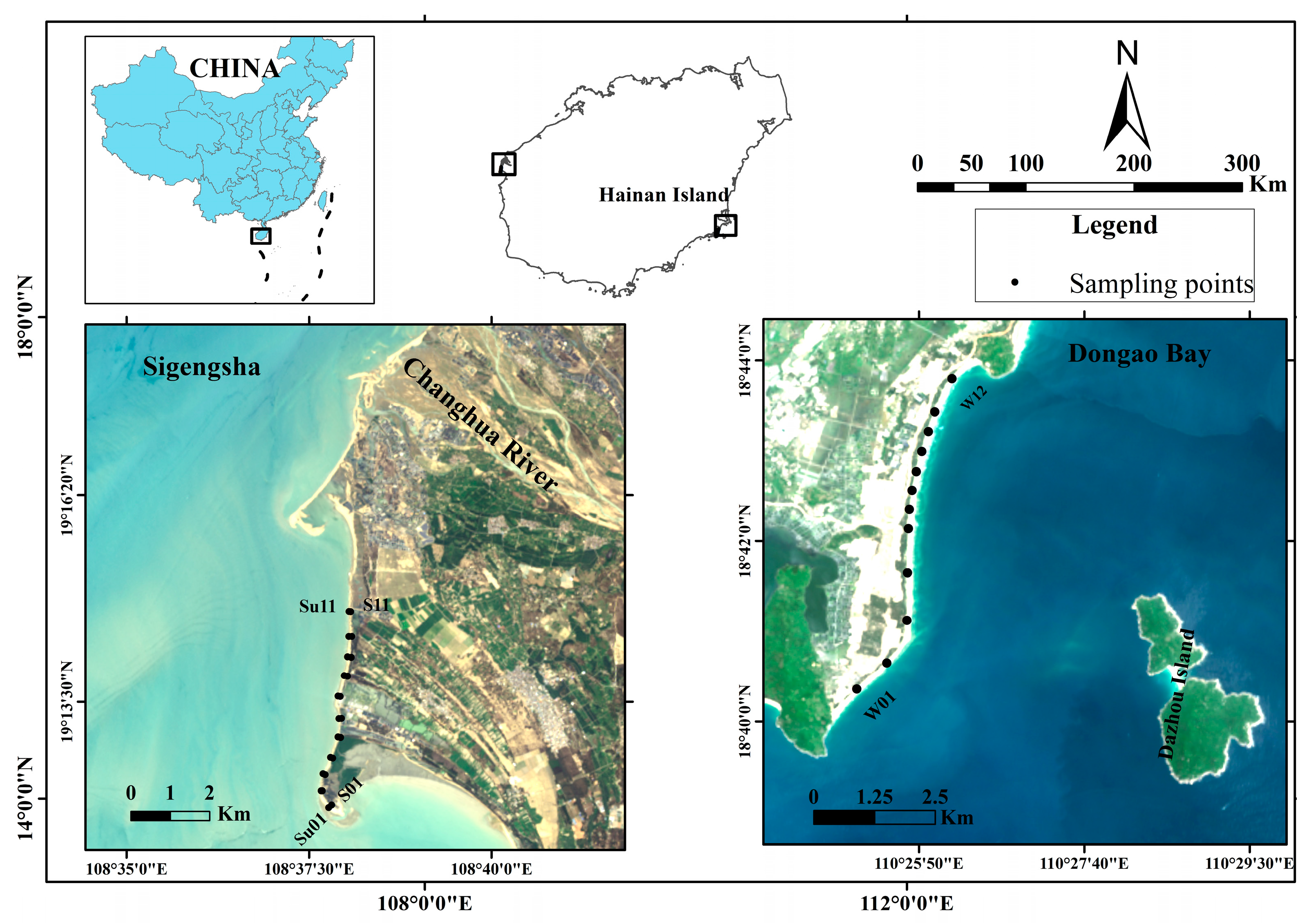
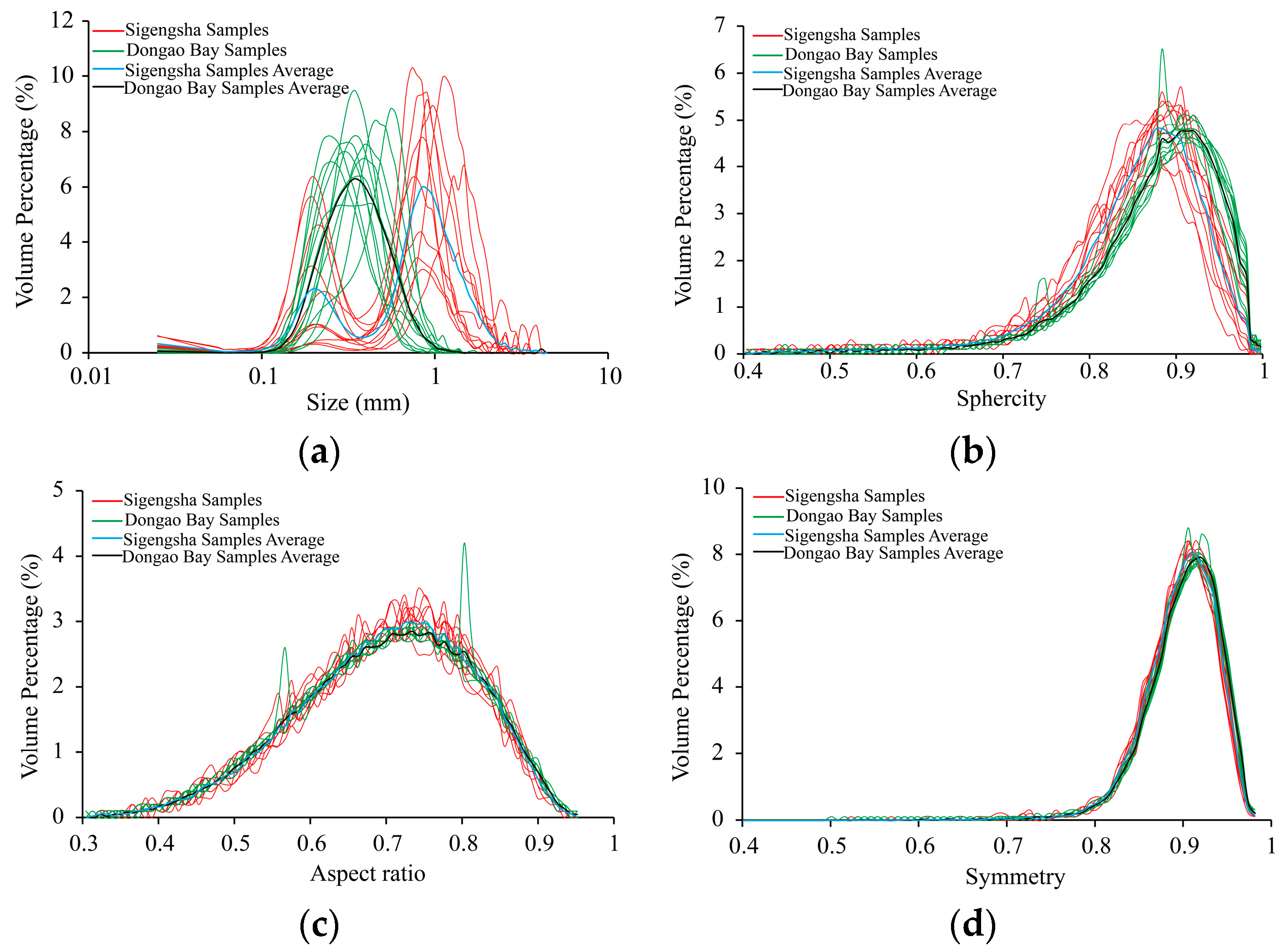



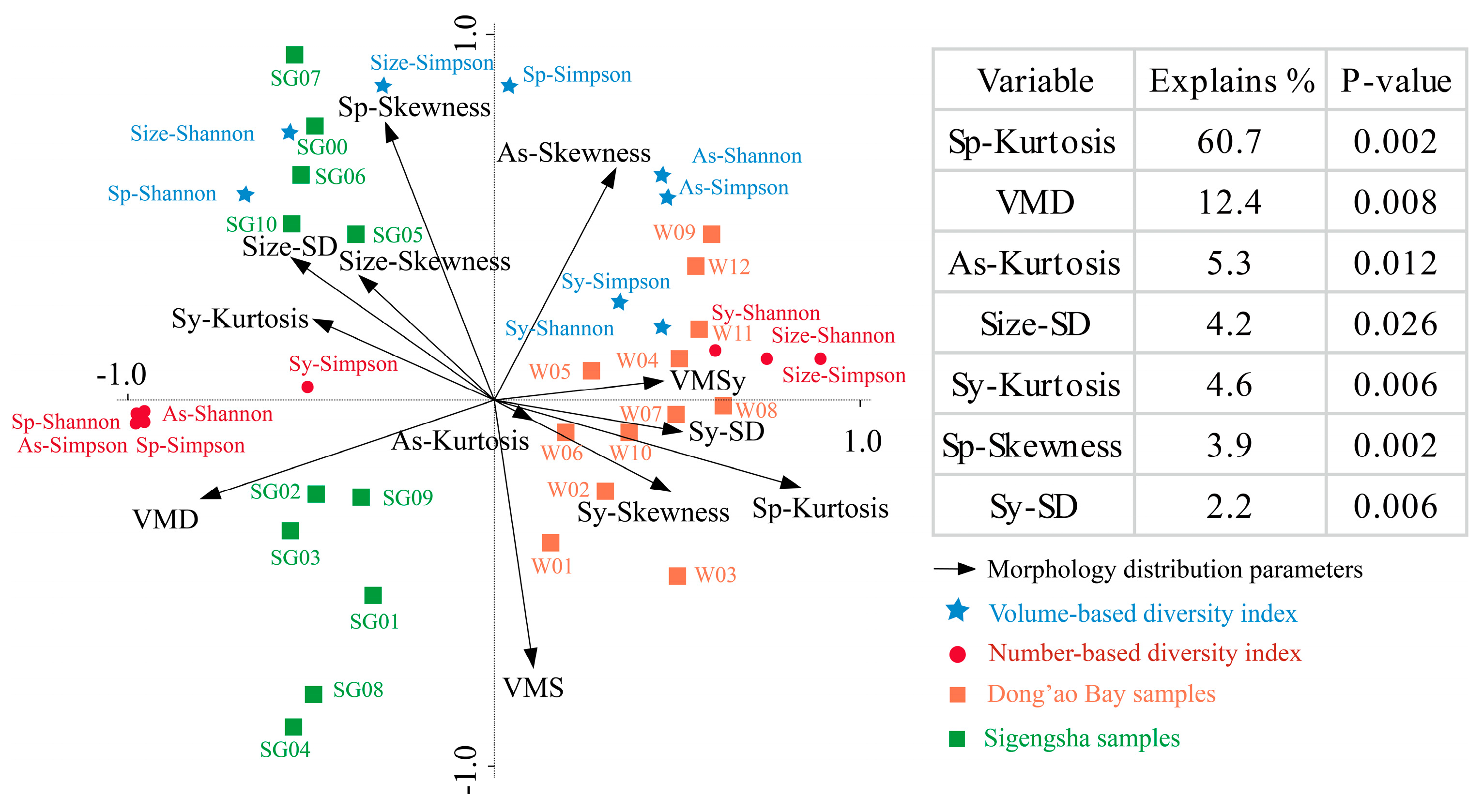
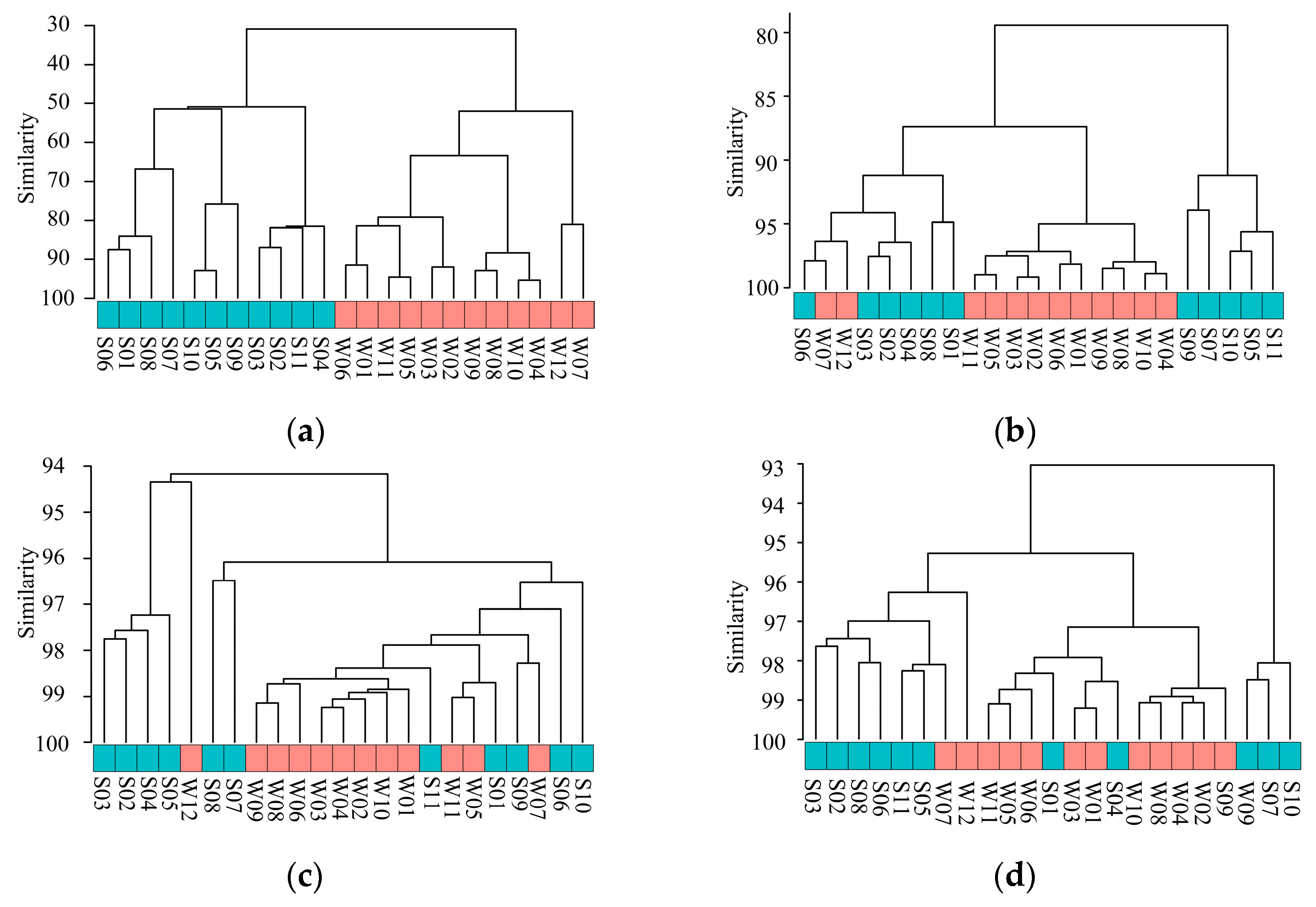

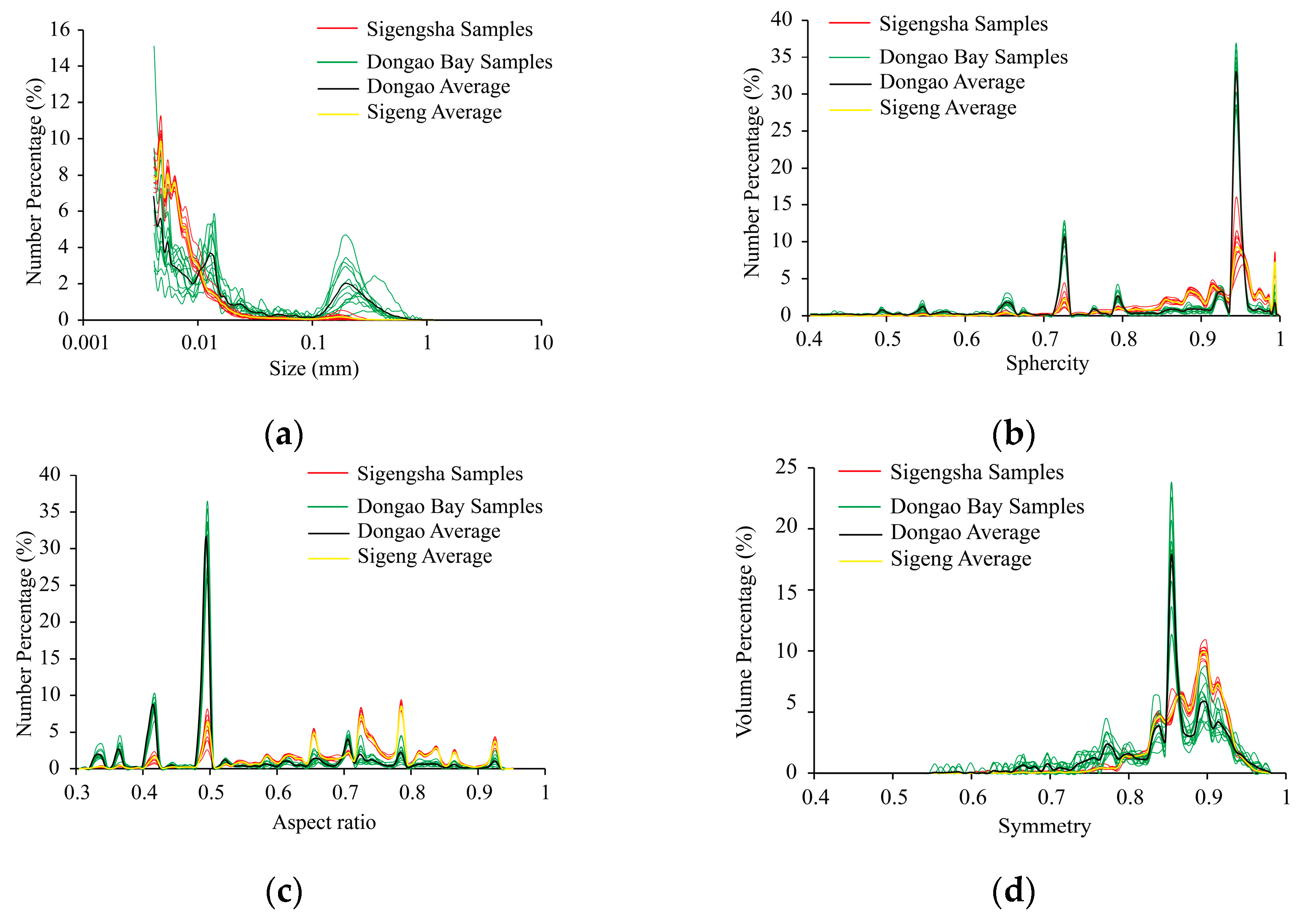
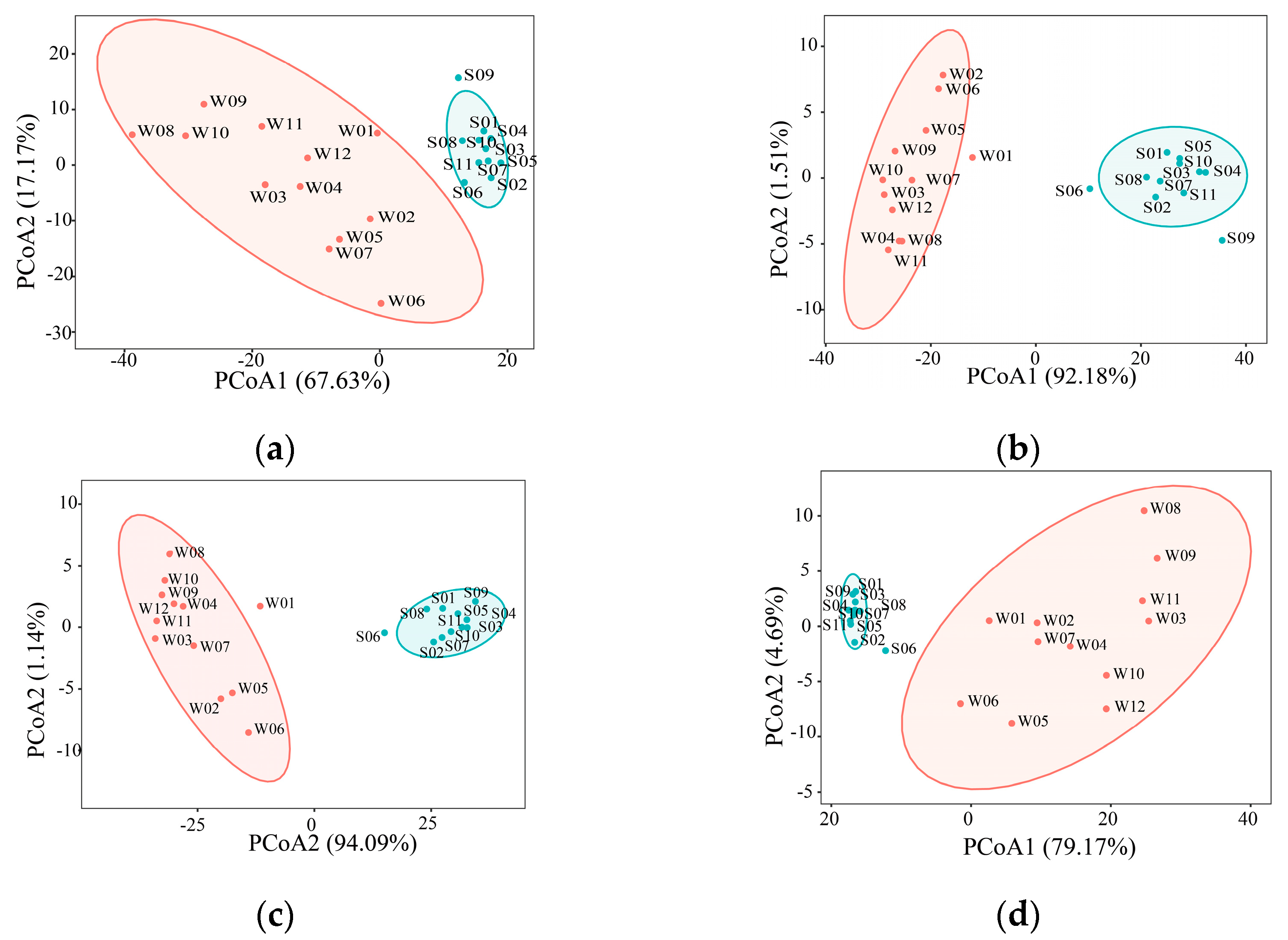
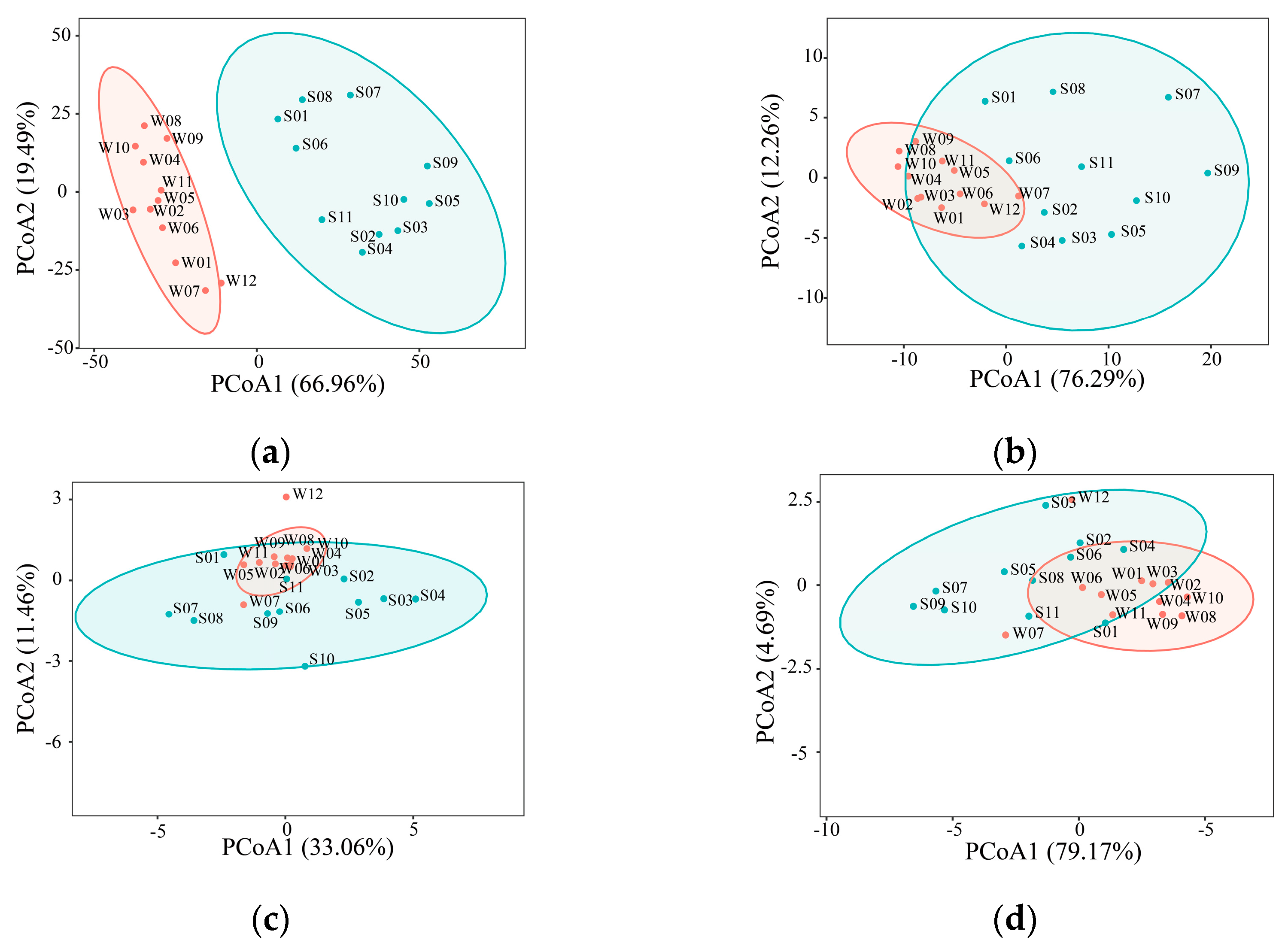



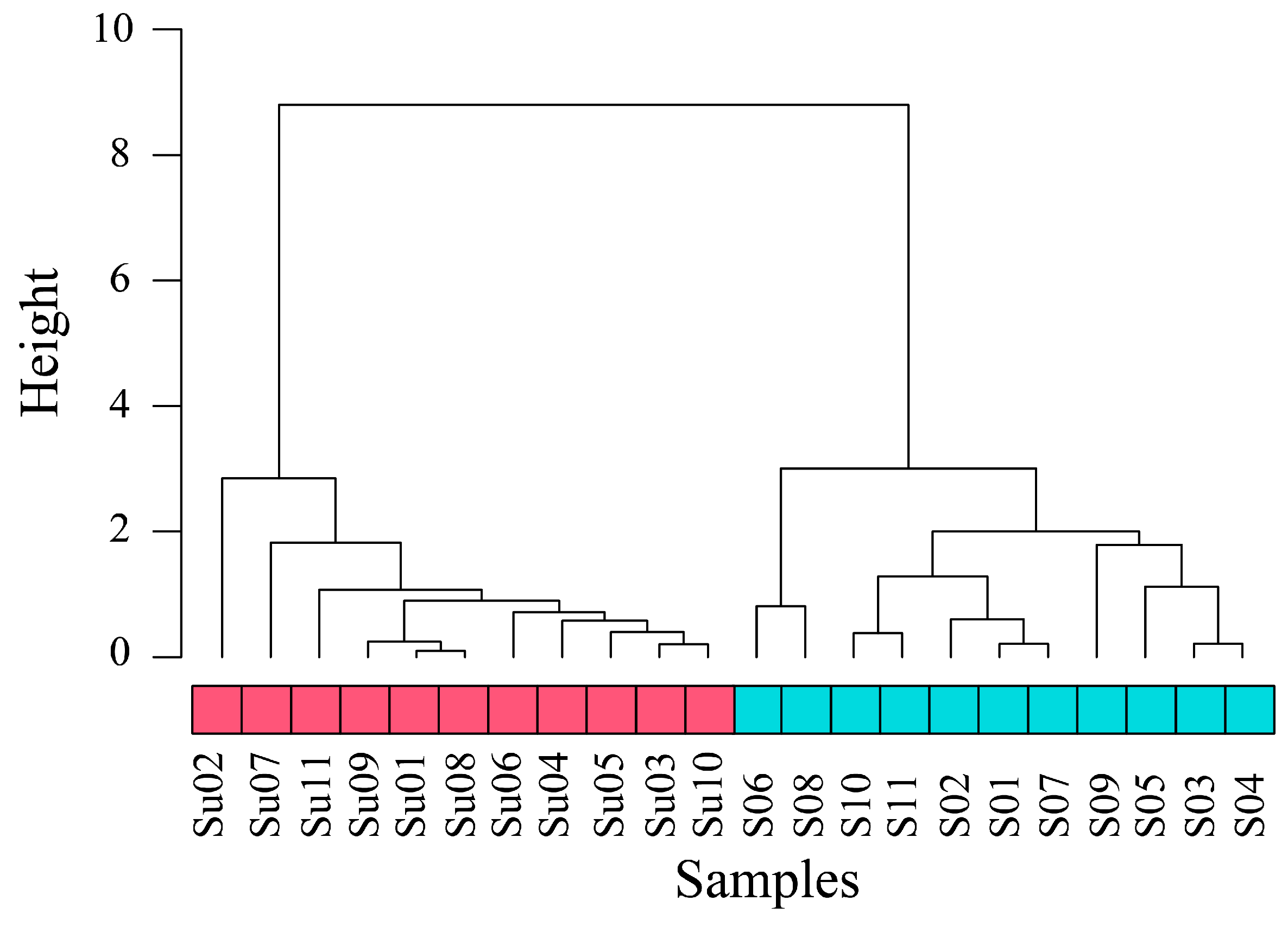
| Diversity Index | |||||
|---|---|---|---|---|---|
| Size | Sphericity | Aspect Ratio | Symmetry | ||
| Distribution parameters | Size | 0.883 ** | 0.414 ** | 0.387 ** | 0.126 ** |
| Sphericity | 0.081 * | 0.072 ** | 0.033 * | 0.003 | |
| Aspect ratio | 0.014 | 0.016 * | 0.009 | 0.000 | |
| Symmetry | 0.045 | 0.068 ** | 0.064 ** | 0.010 | |
| All morphology | 0.935 ** | 0.246 ** | 0.226 ** | 0.139 ** | |
| Statistic | Axis 1 | Axis 2 | Axis 3 | Axis 4 |
|---|---|---|---|---|
| Eigenvalues | 0.864 | 0.070 | 0.015 | 0.006 |
| Explained (cumulative) | 90.07 | 97.40 | 98.93 | 99.54 |
| Morphology parameters–diversity indexes correlation | 0.987 | 0.958 | 0.840 | 0.749 |
Disclaimer/Publisher’s Note: The statements, opinions and data contained in all publications are solely those of the individual author(s) and contributor(s) and not of MDPI and/or the editor(s). MDPI and/or the editor(s) disclaim responsibility for any injury to people or property resulting from any ideas, methods, instructions or products referred to in the content. |
© 2023 by the authors. Licensee MDPI, Basel, Switzerland. This article is an open access article distributed under the terms and conditions of the Creative Commons Attribution (CC BY) license (https://creativecommons.org/licenses/by/4.0/).
Share and Cite
Cheng, W.; Chen, S.; Zhong, X.; Zhao, S. Identification of Sedimentary Environments through Dynamic Image Analysis of the Particle Morphology of Beach Sediments on the East and West Coasts of Hainan Island in South China. Water 2023, 15, 2680. https://doi.org/10.3390/w15152680
Cheng W, Chen S, Zhong X, Zhao S. Identification of Sedimentary Environments through Dynamic Image Analysis of the Particle Morphology of Beach Sediments on the East and West Coasts of Hainan Island in South China. Water. 2023; 15(15):2680. https://doi.org/10.3390/w15152680
Chicago/Turabian StyleCheng, Wufeng, Shenliang Chen, Xiaojing Zhong, and Shaohua Zhao. 2023. "Identification of Sedimentary Environments through Dynamic Image Analysis of the Particle Morphology of Beach Sediments on the East and West Coasts of Hainan Island in South China" Water 15, no. 15: 2680. https://doi.org/10.3390/w15152680
APA StyleCheng, W., Chen, S., Zhong, X., & Zhao, S. (2023). Identification of Sedimentary Environments through Dynamic Image Analysis of the Particle Morphology of Beach Sediments on the East and West Coasts of Hainan Island in South China. Water, 15(15), 2680. https://doi.org/10.3390/w15152680






